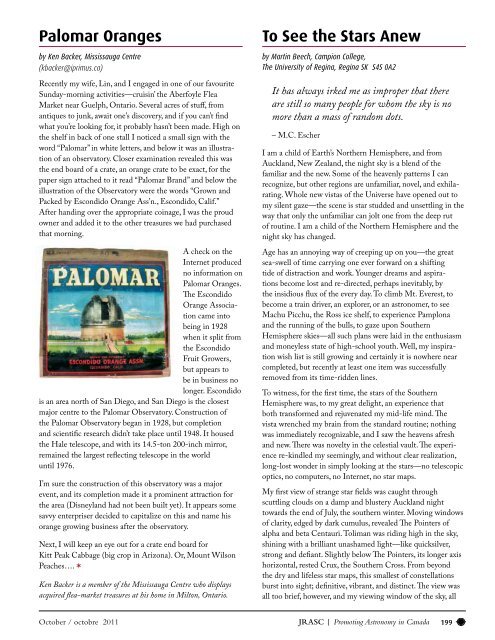The stunning Orion Nebula - The Royal Astronomical Society of ...
The stunning Orion Nebula - The Royal Astronomical Society of ...
The stunning Orion Nebula - The Royal Astronomical Society of ...
Create successful ePaper yourself
Turn your PDF publications into a flip-book with our unique Google optimized e-Paper software.
Palomar Oranges<br />
by Ken Backer, Mississauga Centre<br />
(kbacker@iprimus.ca)<br />
Recently my wife, Lin, and I engaged in one <strong>of</strong> our favourite<br />
Sunday-morning activities—cruisin’ the Aberfoyle Flea<br />
Market near Guelph, Ontario. Several acres <strong>of</strong> stuff, from<br />
antiques to junk, await one’s discovery, and if you can’t find<br />
what you’re looking for, it probably hasn’t been made. High on<br />
the shelf in back <strong>of</strong> one stall I noticed a small sign with the<br />
word “Palomar” in white letters, and below it was an illustration<br />
<strong>of</strong> an observatory. Closer examination revealed this was<br />
the end board <strong>of</strong> a crate, an orange crate to be exact, for the<br />
paper sign attached to it read “Palomar Brand” and below the<br />
illustration <strong>of</strong> the Observatory were the words “Grown and<br />
Packed by Escondido Orange Ass’n., Escondido, Calif.”<br />
After handing over the appropriate coinage, I was the proud<br />
owner and added it to the other treasures we had purchased<br />
that morning.<br />
A check on the<br />
Internet produced<br />
no information on<br />
Palomar Oranges.<br />
<strong>The</strong> Escondido<br />
Orange Association<br />
came into<br />
being in 1928<br />
when it split from<br />
the Escondido<br />
Fruit Growers,<br />
but appears to<br />
be in business no<br />
longer. Escondido<br />
is an area north <strong>of</strong> San Diego, and San Diego is the closest<br />
major centre to the Palomar Observatory. Construction <strong>of</strong><br />
the Palomar Observatory began in 1928, but completion<br />
and scientific research didn’t take place until 1948. It housed<br />
the Hale telescope, and with its 14.5-ton 200-inch mirror,<br />
remained the largest reflecting telescope in the world<br />
until 1976.<br />
I’m sure the construction <strong>of</strong> this observatory was a major<br />
event, and its completion made it a prominent attraction for<br />
the area (Disneyland had not been built yet). It appears some<br />
savvy enterpriser decided to capitalize on this and name his<br />
orange growing business after the observatory.<br />
Next, I will keep an eye out for a crate end board for<br />
Kitt Peak Cabbage (big crop in Arizona). Or, Mount Wilson<br />
Peaches…. V<br />
Ken Backer is a member <strong>of</strong> the Mississauga Centre who displays<br />
acquired flea-market treasures at his home in Milton, Ontario.<br />
To See the Stars Anew<br />
by Martin Beech, Campion College,<br />
<strong>The</strong> University <strong>of</strong> Regina, Regina SK S4S 0A2<br />
It has always irked me as improper that there<br />
are still so many people for whom the sky is no<br />
more than a mass <strong>of</strong> random dots.<br />
– M.C. Escher<br />
I am a child <strong>of</strong> Earth’s Northern Hemisphere, and from<br />
Auckland, New Zealand, the night sky is a blend <strong>of</strong> the<br />
familiar and the new. Some <strong>of</strong> the heavenly patterns I can<br />
recognize, but other regions are unfamiliar, novel, and exhilarating.<br />
Whole new vistas <strong>of</strong> the Universe have opened out to<br />
my silent gaze—the scene is star studded and unsettling in the<br />
way that only the unfamiliar can jolt one from the deep rut<br />
<strong>of</strong> routine. I am a child <strong>of</strong> the Northern Hemisphere and the<br />
night sky has changed.<br />
Age has an annoying way <strong>of</strong> creeping up on you—the great<br />
sea-swell <strong>of</strong> time carrying one ever forward on a shifting<br />
tide <strong>of</strong> distraction and work. Younger dreams and aspirations<br />
become lost and re-directed, perhaps inevitably, by<br />
the insidious flux <strong>of</strong> the every day. To climb Mt. Everest, to<br />
become a train driver, an explorer, or an astronomer, to see<br />
Machu Picchu, the Ross ice shelf, to experience Pamplona<br />
and the running <strong>of</strong> the bulls, to gaze upon Southern<br />
Hemisphere skies—all such plans were laid in the enthusiasm<br />
and moneyless state <strong>of</strong> high-school youth. Well, my inspiration<br />
wish list is still growing and certainly it is nowhere near<br />
completed, but recently at least one item was successfully<br />
removed from its time-ridden lines.<br />
To witness, for the first time, the stars <strong>of</strong> the Southern<br />
Hemisphere was, to my great delight, an experience that<br />
both transformed and rejuvenated my mid-life mind. <strong>The</strong><br />
vista wrenched my brain from the standard routine; nothing<br />
was immediately recognizable, and I saw the heavens afresh<br />
and new. <strong>The</strong>re was novelty in the celestial vault. <strong>The</strong> experience<br />
re-kindled my seemingly, and without clear realization,<br />
long-lost wonder in simply looking at the stars—no telescopic<br />
optics, no computers, no Internet, no star maps.<br />
My first view <strong>of</strong> strange star fields was caught through<br />
scuttling clouds on a damp and blustery Auckland night<br />
towards the end <strong>of</strong> July, the southern winter. Moving windows<br />
<strong>of</strong> clarity, edged by dark cumulus, revealed <strong>The</strong> Pointers <strong>of</strong><br />
alpha and beta Centauri. Toliman was riding high in the sky,<br />
shining with a brilliant unashamed light—like quicksilver,<br />
strong and defiant. Slightly below <strong>The</strong> Pointers, its longer axis<br />
horizontal, rested Crux, the Southern Cross. From beyond<br />
the dry and lifeless star maps, this smallest <strong>of</strong> constellations<br />
burst into sight; definitive, vibrant, and distinct. <strong>The</strong> view was<br />
all too brief, however, and my viewing window <strong>of</strong> the sky, all<br />
October / octobre 2011 JRASC | Promoting Astronomy in Canada<br />
199

















